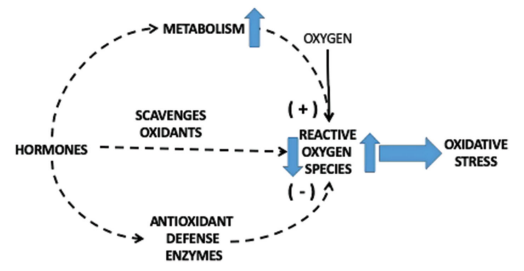Oxidative Stress Detection Services
Creative Bioarray provides comprehensive service options for cell function determination and analysis, and our cell oxidative stress assessment platform provides a variety of related technical services. Through high-quality reagent products and experienced laboratories, we conduct a comprehensive evaluation and analysis of the oxidative stress state of the cell samples commissioned or submitted by customers. This service aims to provide customers with samples of reactive oxygen species determination, cell oxidative damage assessment, and antioxidant status assessment. We have established a mature agreement and can provide an ideal solution with a fast turnaround time according to your requirements.
Reactive Oxygen Species (ROS) and Oxidative Stress (OS)
Reactive oxygen species (ROS) are chemically active molecules that contain oxygen, which exert a variety of beneficial effects on organisms. ROS can be produced by endogenous normal cell oxygen metabolism, and can also be induced by exogenous sources such as ultraviolet light and lifestyle. At low/medium concentrations, they are necessary for physiological activities such as intracellular cell signal transduction and homeostasis, cell death, immune defense, and induction of mitotic reactions. However, when the antioxidant system that metabolizes ROS is overloaded (the imbalance between the production of ROS and the antioxidant defense of the cell), oxidative stress (OS) will occur. The harmful effects of oxidative stress caused by ROS are related to human diseases and aging. Excess free radicals produced under OS conditions can cause oxidative damage to proteins, lipids and nucleic acids, severely damage cell health and lead to disease development. Our oxidative stress testing service provides ROS types to detect glutathione, ROS changes, and analysis to evaluate the oxidative damage and antioxidant function of cells.
 Fig 1. An overview of ROS generation and antioxidant Defence system. (Chainy G B N, et al. 2020)
Fig 1. An overview of ROS generation and antioxidant Defence system. (Chainy G B N, et al. 2020)
Reactive Oxygen Species Measurement Services
ROS includes hydrogen peroxide, peroxide free radicals, superoxide, peroxynitrite, hydroxyl free radicals, singlet oxygen and other oxygen-containing active chemical substances, which have transient characteristics and have high requirements for samples. Our ROS detection service includes total ROS detection and selective ROS detection. Selective ROS detection is mainly used to analyze one or more targets of interest to customers. Customers can choose appropriate test items according to the purpose of the experiment. We use high-quality fluorescent dyes to stain and image cells to provide customers with high-quality published data.
Oxidation Damage/Antioxidant Status Assessment Services
Oxidative loss is an important indicator that reflects the oxidative stress state of cells. The oxidative damage caused by excessive free radicals to proteins, lipids and nucleic acids can seriously damage cell health. This service can evaluate oxidative damage in cells, including lipid peroxidation and DNA damage. Taking lipid peroxidation as an example, the byproducts of lipid peroxidation after oxidative damage will directly damage cell membranes. We evaluate the degree of oxidative damage of cells through the detection of lipid peroxidation markers, DNA damage by-products and other targets that are of interest to customers, and help customers acquire relevant knowledge.
At the same time, assessing the antioxidant status of the cells can also reflect the oxidative stress status of the cells. For example, the classic antioxidant glutathione found in eukaryotic cells. The most common is the reduced form of reduced glutathione (GSH), and the oxidized form (GSSG). GSH level can be used to indicate redox potential and the ability of cells to prevent oxidative stress, while GSSG can be used as an important indicator of the performance of cellular oxidative stress. Our antioxidant assessment service options include total glutathione assessment (GSH Assay) and GSH/GSSG ratio testing. Sensitive detection and localization of sulfhydryl groups by suitable intracellular fluorescent probes enables rapid analysis of GSH.In addition, this service can also choose to evaluate the activity of enzymes related to the production and metabolism of peroxides to assess the level of oxidative stress, such as catalase, superoxide dismutase, and glutathione peroxidase.
 Fig 2. Multi-dimensional assessment of oxidative stress.
Fig 2. Multi-dimensional assessment of oxidative stress.
Creative Bioarray provides comprehensive cellular oxidative stress assessment services, mainly for the analysis and determination of pathways and products related to reactive oxygen metabolism. Our oxidative stress assessment service provides a variety of technical service options, and customers can make diversified choices based on samples and experimental needs. We will use our technical expertise to provide you with the most suitable solution. If you are interested in our services or have any specific needs, please contact us. We look forward to working with you in the near future.
References:
- Chainy G B N, Sahoo D K. Hormones and oxidative stress: an overview[J]. Free radical research, 2020, 54(1): 1-26.
- Katerji M, Filippova M, Duerksen-Hughes P. Approaches and methods to measure oxidative stress in clinical samples: Research applications in the cancer field[J]. Oxidative medicine and cellular longevity, 2019, 2019.
For research use only. Not for any other purpose.

 Fig 1. An overview of ROS generation and antioxidant Defence system. (Chainy G B N, et al. 2020)
Fig 1. An overview of ROS generation and antioxidant Defence system. (Chainy G B N, et al. 2020)  Fig 2. Multi-dimensional assessment of oxidative stress.
Fig 2. Multi-dimensional assessment of oxidative stress. 